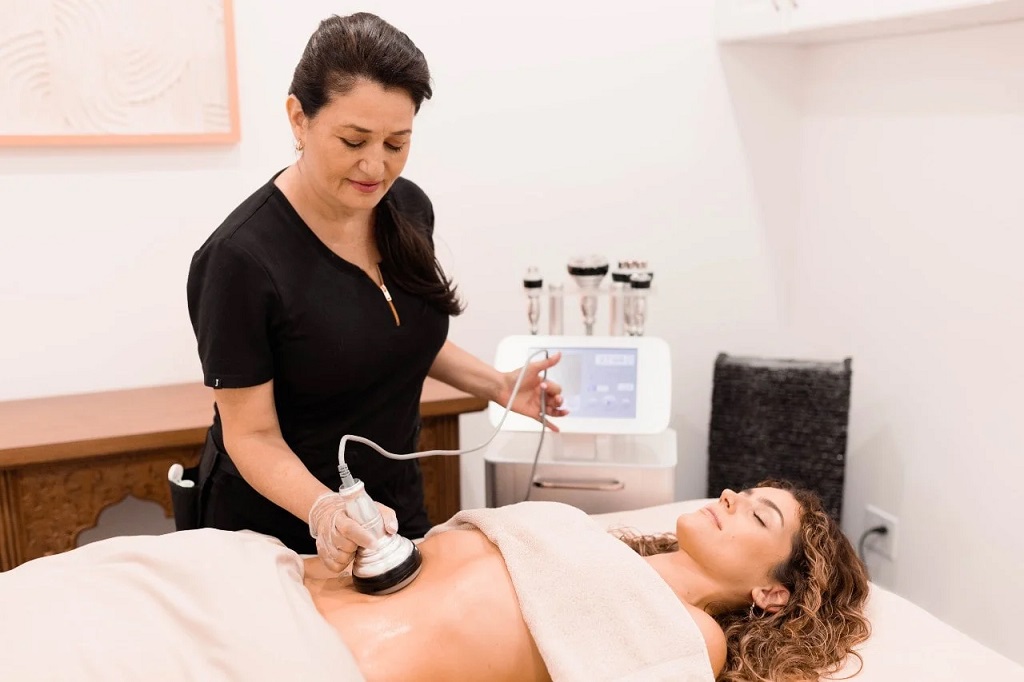
11 Oct Is Home Cavitation Safe
Cavitation has become a popular buzzword in the beauty industry, with many at-home devices claiming to offer this treatment. But what exactly is cavitation and more importantly, is it safe to use at home? In this article, we will delve into the science behind cavitation and address any safety concerns you may have.
What is Cavitation?
Cavitation is a non-invasive cosmetic procedure that uses ultrasound waves to break down fat cells in the body. This process, also known as “ultrasonic lipolysis,” can target specific areas of the body such as the stomach, thighs, and arms. If you’re wondering do at home cavitation machines work, it’s important to note that they can provide similar results when used correctly and consistently.
During a cavitation treatment, a handheld device emits high-frequency sound waves that penetrate through the skin and into the fatty tissue. These sound waves create a vibration within the fat cells, causing them to burst and release their contents into the surrounding fluid.
The released fat is then metabolized by the body’s lymphatic system and eliminated through natural processes. This results in a reduction in the appearance of cellulite and inches off targeted areas.

Is Home Cavitation Safe?
Now that we have a better understanding of what cavitation is, let’s address the safety concerns surrounding at-home cavitation devices.
The short answer is yes, home cavitation can be safe when used correctly. However, there are some factors to consider before purchasing an at-home device.
Quality of the Device
First and foremost, it is essential to invest in a high-quality at-home cavitation device. Cheaper, low-quality devices may not have the necessary safety mechanisms in place and could potentially cause harm.
Look for devices that are FDA-approved and have been tested for safety and effectiveness. It is also beneficial to read reviews from other users before making a purchase.
Proper Usage
Like any beauty treatment, it is crucial to follow the instructions carefully when using an at-home cavitation device. Improper usage can lead to adverse effects such as burns, bruising, and skin irritation.
Make sure to clean the treatment area and apply a conductive gel before using the device. It is also essential to move the device in slow, circular motions and not leave it on one spot for too long.
Contraindications
Cavitation is generally safe for most people, but there are some contraindications to consider. It is not recommended for pregnant or breastfeeding women as well as those with metal implants or medical conditions such as heart disease and diabetes.
If you have any concerns about your health, it is always best to consult with a medical professional before trying any at-home treatment.
Benefits of Home Cavitation
Aside from its effectiveness in reducing fat and cellulite, there are several benefits to using an at-home cavitation device.
Cost-Effective
Professional cavitation treatments can be expensive, making it inaccessible for many people. With an at-home device, you only have to make a one-time investment and can continue treatments as needed without additional costs.
Convenience
Having the ability to perform cavitation treatments at home also offers convenience. You can schedule treatments around your own time and avoid the hassle of going to a spa or clinic.
Non-Invasive
Compared to other fat reduction procedures, cavitation is non-invasive, meaning there are no incisions or needles involved. This reduces the risk of infection and eliminates any downtime for recovery.
Frequently Asked Questions
Q: Can I use home cavitation on my face?
A: No, home cavitation devices are not recommended for use on the face. The skin on the face is more delicate and may be easily damaged by the high-frequency sound waves.
Q: How often should I use an at-home cavitation device?
A: It is recommended to use an at-home cavitation device 2-3 times a week for best results.
Q: Can I use home cavitation if I have a pacemaker?
A: No, individuals with electronic medical devices such as pacemakers should not use home cavitation devices as it may interfere with the functioning of the device.
Q: Will I see immediate results with home cavitation?
A: Results may vary, but most people see visible changes after multiple treatments. Consistency and following proper usage instructions are key.
Q: Can I combine home cavitation with other treatments?
A: It is generally safe to combine home cavitation with other non-invasive procedures such as radiofrequency or laser therapy. However, it is always best to consult with a medical professional before combining treatments.
Conclusion
Home cavitation can be a safe and effective way to reduce fat and cellulite in targeted areas. It is essential to invest in a high-quality device, follow proper usage instructions, and consider any contraindications before trying at-home cavitation.
Why do you need a hand and foot spa? Well, just like you prioritize your overall health and well-being by consulting with a medical professional, indulging in regular hand and foot spa treatments can also contribute to your self-care routine. With consistency and proper usage, these soothing sessions can help you achieve relaxation and rejuvenation in the comfort of your own home. So why not give it a try and experience the revitalizing results for yourself?”



Sorry, the comment form is closed at this time.